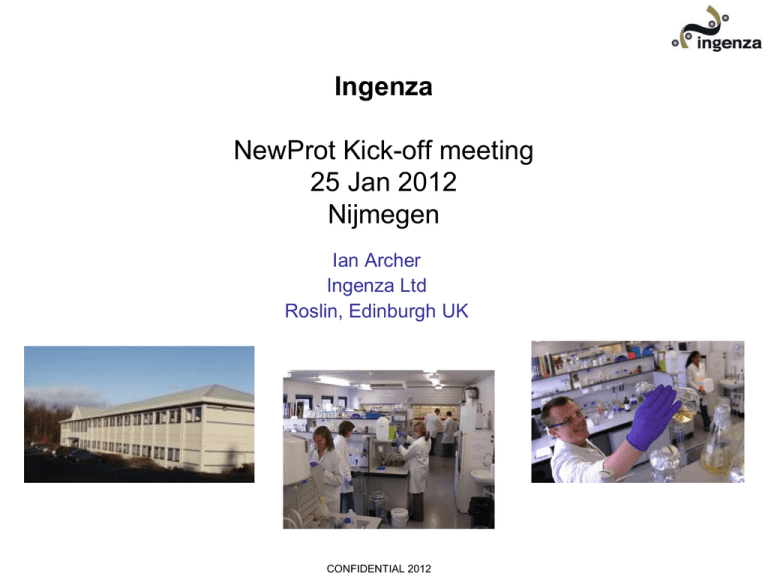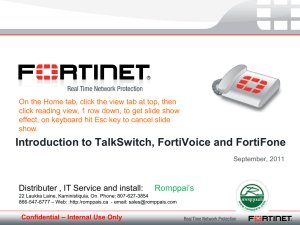INGEN partner presentation
advertisement

Ingenza NewProt Kick-off meeting 25 Jan 2012 Nijmegen Ian Archer Ingenza Ltd Roslin, Edinburgh UK CONFIDENTIAL 2012 Ingenza – what we do Synthetic Biology Technologies Biocatalysis/Bioprocess development Protein expression/enzyme evolution Screening for improved biocatalysts/processes Novel enabling technologies e.g. gENABLE Business areas Fine chemicals Biologics Biofuels Synthetic biology / petrochemical replacement Biopolymers Diagnostics CONFIDENTIAL 2012 Initial company focus: biosynthesis of chiral compounds Engineered microbial biocatalysts • Platform technologies – – e.g. oxidase and aminotransferase biocatalysts Unnatural amino acids and chiral amines • Large scale processes, compounds >99% e.e. – Highly expressed enzymes – High cell density fermentation – Efficient process chemistry • Enzymes adapted by mutation/screening – New specificities – Improved reaction properties • Process optimisation – Stabilised biocatalysts – Diverse enzyme production systems – Biocatalyst formulation – Statistical design of experiments CONFIDENTIAL 2012 Expression systems Continuing to expand and diversify • Bacteria: E.coli – Large range of host/vector systems – Inducible, constitutive, synthetic • C.glutamicum / C.acetobutylicum – Customising host/vector systems • Yeast: Saccharomyces, Pichia – Range of host/vector systems – Cytosolic/Partitioned/Secretion – Integration vectors/copy number control – Fusions to identify novel regulatory regions • Fungi: A.niger, A. terreus – Customising host/vector systems – Inducible/Constitutive • Insect cell/mammalian – Production of biologics CONFIDENTIAL 2012 Screening to adapt enzyme specificity or improve performance Colorimetric, qualitative solid phase/quantitative liquid phase oxidase HRP Substrate • • • Micro-titre plate assay Straight forward visual read-out Kinetic characterisation of variants CONFIDENTIAL 2012 • • • Adapted to solid phase Proprietary Very high throughput – Millions of variants Colorimetric screening Improved enzyme activity or protein expression • The screen detects – improved activity AND/OR – improved expression Can be used in conjunction with: • Gene synthesis, now standard in molecular biology • Gene assembly methods to rapidly generate expression libraries • Assists selection of the optimal expression system • Assists selection of the optimal gene sequence • Delivers the highest quantity and quality of expressed protein – Screening libraries is a powerful tool CONFIDENTIAL 2012 Enzyme adaptation: Increased enzyme thermostability/robustness • Three rounds of laboratory evolution Wild-type TvDAAO heat treatment assay Variant WT1 TvDAAO heat treatment assay 250 250 45˚C 50.4˚C 55.8˚C 61˚C 65.6˚C 150 100 200 mOD/min mOD/min 200 50 45˚C 50.4˚C 55.8˚C 61˚C 65.6˚C 150 100 50 0 0 0 10 20 30 40 50 60 70 80 90 100 0 Time (mins) • 10 20 30 40 50 60 70 80 90 100 Time (mins) Not stable in process – Susceptible to chemical denaturation – Susceptible to physical denaturation • CONFIDENTIAL 2012 Stable in process – Resistant to chemical denaturation – Resistant to physical denaturation Screening for efficient protein production Applied to biologic target to identify top 50 from 50,000 Library built (50,000 variants) Oversampled (500,000 clones) Hits identified visually 500 initial positive hits - re-assayed - PCR screen to confirm - liquid phase assay to quantify 50 Best hits identified - sub-cloned - SDS-PAGE/Western assay - Provided to customer Over-expressing clone CONFIDENTIAL 2012 Synthetic biology Replacement of petrochemical and other starting materials • Partnership with Lucite International – – – – – – – Global producer of industrial polymers Engaged in multi year contract Microbial strain construction Synthetic Biology – pathway engineering Screening: Crossfeeding, Zone clearing, pH based Fermentation development Management of strategic academic collaboration • Additional contracts now initiated – – – – – Biomass as replacement for petrochemical feedstock Fermentation route to natural food additive Multi-target Synthetic Biology to develop efficient production microbes Bacteria/Yeast/Fungi • Proprietary genetic platforms accelerate strain improvement CONFIDENTIAL 2012 gENABLE – Genome segment assembly • • • • • • Co-developed by Ingenza and Scottish Government Ingenza applying broadly in Industrial Biotechnology Assembly of genes, variants, reporters, markers, regulatory elements High-throughput, one-pot combinatorial assemblies Combines Bioinformatics, Microfluidics, Novel bio-reactions Accelerates: – Optimisation of gene expression – Pathway construction/engineering – Efficient synthesis of target products • Applicable in all areas of protein expression • Now central to all Ingenza enabling technologies and business areas • Synergistic with screening • Colorimetric, pH, crossfeeding, zone clearing, protein fusions CONFIDENTIAL 2012 gENABLE Why? Expressing proteins is easy - isn’t it? Welch. M. Journal of the Royal Society. Interface 11th March (2009) CONFIDENTIAL 2012 gENABLE Specific linker based genetic pathway construction Assemblies of up to 10 parts have been demonstrated CONFIDENTIAL 2012 gENABLE 5 part combinatorial assembly for co-ordinated enzyme expression Position A Pr. 1 Gene 1 Position B Ter. Pr. 1 Position C Ter. Gene 2 Pr. 1 Gene 3 Position D Position E Ter. 2 µ origin Pr. 2 Gene 1 Ter. Pr. 2 Ter. Gene 2 Pr. 2 Gene 3 Ter. Marker CEN4 origin Pr. 3 Gene 1 3 variants Ter. Pr. 3 Gene 2 Ter. Gene 3 Pr. 3 3 variants 3 variants Ter. 1 marker 2 origins of replication Vector backbones Assembly of 54 different genetic constructs in a single reaction Overcomes limits of empirical bioprocess optimisation Faster route to optimal bioprocess CONFIDENTIAL 2012 gENABLE Example of results • Combination of 5 independent DNA fragments • Assembly of synthetic enzyme pathway • Typically a problematic empirical process • Results in 95% success in correct pathway assembly (dark clones) > 95 % positive clones CONFIDENTIAL 2012 NewProt Workpackage 6 @ Ingenza Experimental validation Tasks 1. Bioinformatics to identify aminotransferases (plus as many as possible of at least another 11 enzyme superfamilies) with diverse, novel activities towards commercially specific targets 2. Pathway engineering to incorporate activities into hosts 3. Develop screens to identify best production constructs 4. Screening of libraries to identify desired activities Focus areas? 1. Enzyme promiscuity to identify novel activities 2. Use of bioinformatics to demystify expression / activity etc CONFIDENTIAL 2012







